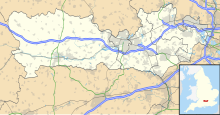
Back بیرینجی نیوبری دؤیوشو AZB Première bataille de Newbury French Battaglia di Newbury (1643) Italian Bitwa pod Newbury (1643) Polish Первая битва при Ньюбери Russian Битка код Њуберија (1643) Serbian ยุทธการที่นิวบรีครั้งที่ 1 Thai
| First Battle of Newbury | |||||||
|---|---|---|---|---|---|---|---|
| Part of the First English Civil War | |||||||
 | |||||||
| |||||||
| Belligerents | |||||||
|
|
| ||||||
| Commanders and leaders | |||||||
|
| ||||||
| Strength | |||||||
| 6,000 cavalry, 8,000 infantry [1] | 4,000 cavalry, 10,000 infantry [1] | ||||||
| Casualties and losses | |||||||
| 1,300 | 1,200 | ||||||
Berkshire | |||||||
The First Battle of Newbury was a battle of the First English Civil War that was fought on 20 September 1643 between a Royalist army, under the personal command of King Charles, and a Parliamentarian force led by the Earl of Essex. Following a year of Royalist successes in which they took Banbury, Oxford and Reading without conflict before storming Bristol, the Parliamentarians were left without an effective army in the west of England. When Charles laid siege to Gloucester, Parliament was forced to muster a force under Essex with which to beat Charles' forces off. After a long march, Essex surprised the Royalists and forced them away from Gloucester before beginning a retreat to London. Charles rallied his forces and pursued Essex, overtaking the Parliamentarian army at Newbury and forcing them to march past the Royalist force to continue their retreat.
Essex reacted by making a surprise attack on the Royalist lines at dawn, capturing several pieces of high ground and leaving Charles on the back foot. A series of Royalist attacks led to a large number of casualties and the slow retreat of Essex's force, which was driven from the central hill and almost encircled; Essex succeeded in rallying his infantry, however, and pushed forward in a counter-attack. The slowing of this counter-attack in the face of the Royalist cavalry forced Essex to send for reinforcements, who, while marching to him, were attacked and forced to retreat. This left a hole in the Parliamentarian line, dividing the army into two wings through which the Royalists hoped to pass, splitting the Parliamentarians and allowing Charles's troops to encircle and defeat them. In line with this, the Royalists moved forward to press the attack, but were forced to halt by the London Trained Bands. With night falling, the battle ended, and both exhausted armies disengaged. The next morning, low on ammunition, the Royalists were forced to allow Essex to pass and continue his retreat to London.
Reasons for the Royalist failure to defeat the Parliamentarians include shortage of ammunition, the relative lack of professionalism of their soldiers and the tactics of Essex, who compensated "for his much lamented paucity of cavalry by tactical ingenuity and firepower",[2] countering Prince Rupert's cavalry by driving them off with mass infantry formations. Although the numbers of casualties were relatively small (1,300 Royalists and 1,200 Parliamentarians), historians who have studied the battle consider it to be one of the most crucial of the First English Civil War, marking the high point of the Royalist advance and leading to the signing of the Solemn League and Covenant, which brought the Scottish Covenanters into the war on the side of Parliament and led to the eventual victory of the Parliamentarian cause.
- ^ a b Young 1964, p. 133.
- ^ Day (2007), p. 216.
© MMXXIII Rich X Search. We shall prevail. All rights reserved. Rich X Search
